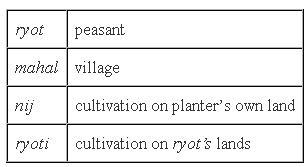Class 8 NCERT Solutions History Chapter 3 - Ruling the Countryside
Ruling the Countryside Exercise 37
Solution 1

Solution 2
(a)Growers of woad in Europe saw indigo as a crop which would provide competition to their earnings.
(b) The demand for indigo increased in late-eighteenth-century Britain because of the expansion of cotton production as a result of industrialisation, which in turn created an enormous demand for cloth dyes.
(c)The international demand for indigo was affected by the discovery of synthetic dyes.
(d)The Champaran movement was against the indigo planters.
Solution 3
As the Company was worried about the declining revenues, she introduced the Permanent Settlement of Bengal in 1793.
According to this settlement, the rajas and the taluqdars were recognised as the zamindars of the land. They had to collect rent from the peasants and pay the revenues to the Company. The amount to be paid to the Company was fixed permanently. This, the Company thought would ensure a steady and regular flow of revenues to them and would encourage the zamindar to invest in the improvement of the land.
Solution 4
|
Mahalwari Settlement |
Permanent Settlement |
|
The mahalwari system was devised by Holt Mackenzie. It was promulgated in 1822, in the North Western provinces of the Bengal Presidency. |
The permanent Settlement was introduced by Lord Cornwallis in 1793. |
|
This system was devised as an alternative to the Permanent Settlement as the British felt that the revenues could not be fixed permanently at a time when more money was required to meet the expenses of administration and trade. |
It was aimed at ensuring stable revenue for the East India Company and encouraging zamindars to invest in improving the land. |
|
The village headmen were in charge of collecting revenue. |
The rajas and taluqdars were in charge of collecting revenue. |
|
The revenue amount was not fixed, and was to be revised periodically. The estimated revenue of each plot within a village was added up to calculate the revenue that each village or mahal had to pay. |
The revenue amount was fixed and was never to be increased in the future. |
Ruling the Countryside Exercise 38
Solution 5
Under the new Munro system of fixing revenue, the revenue officials were driven by the desire to increase income from the land revenues. The demand of high revenues could not be met by the peasants. Consequently, the peasants deserted their villages and fled to the nearby forests.
Solution 6
The European planters forced the ryots to sign a contract to grow indigo on 25% of their land holdings. The farmers who signed the contract were paid money in advance to grow indigo. After the indigo plant was given to the planters after the harvests, farmers were given new loans for growing indigo. The peasants who received advanced loans from the planters realised that the prices they received for the indigo plant was too low and they were always involved in the cycle of debt. Indigo had to be grown on the fertile soil. However, it exhausted the fertility of the soil. The farmers always preferred to grow rice on the fertile soil as once indigo was cultivated, the fertility of the soil decreased. Thus the ryots were reluctant to grow indigo.
Solution 7
The indigo farmers began to rise in rebellion as they thought that they had the support of village headmen in their rebellion. The headmen who were forced to sign the contract fought battles with the agents of the indigo planters. The zamindars also supported the farmers as they were unhappy with the increasing powers of the planters. The indigo farmers also believed that the British government would support them in their rebellion against the planters. This was because the government did not wanted another rebellion after the Revolt of 1857.
After the beginning of the indigo rebellion, many intellectuals from Calcutta began to visit these villages and wrote about the tyranny of the planters and the miseries of the ryots. A Commission was constituted to by the government which held the planters guilty to using coercive methods to deal with the indigo peasants. The Comission also laid down that the ryots after fulfilling the conditions of their contract may refuse to grow indigo on their field. This eventually led to the eventual collapse of indigo plantation in Bengal.

